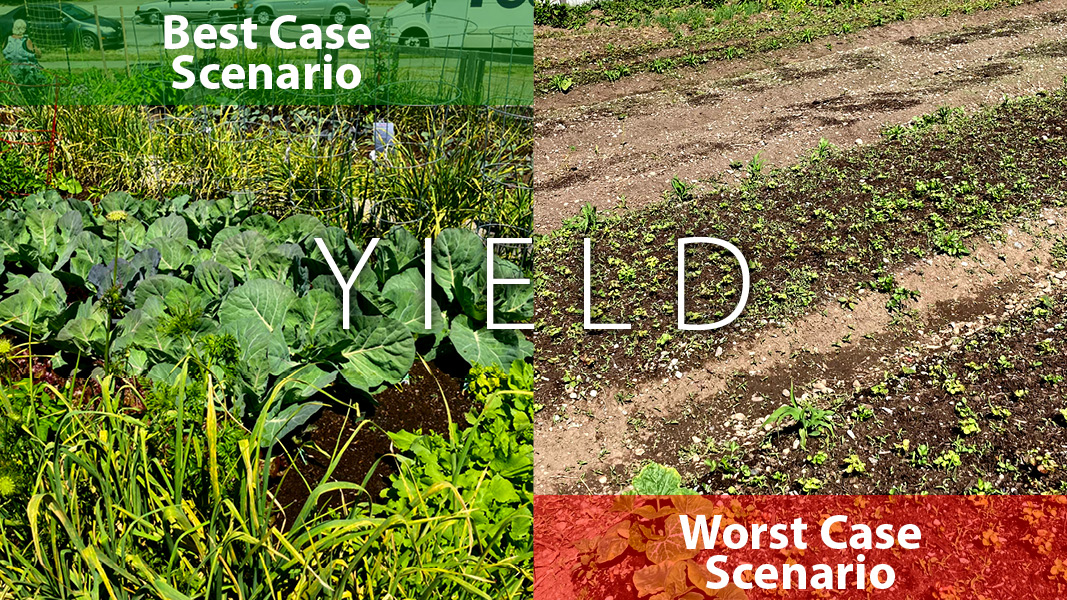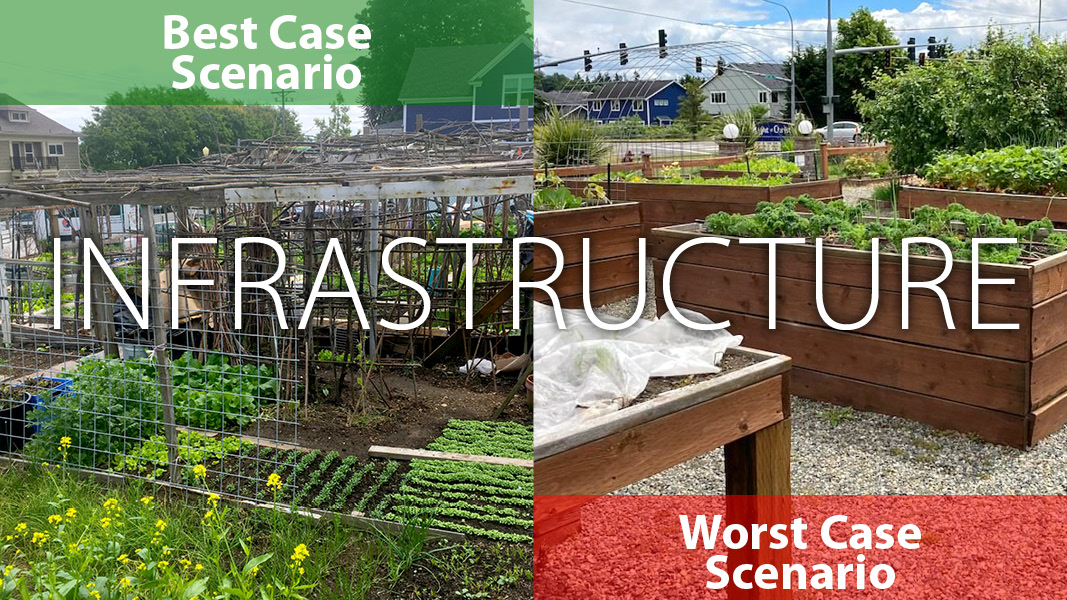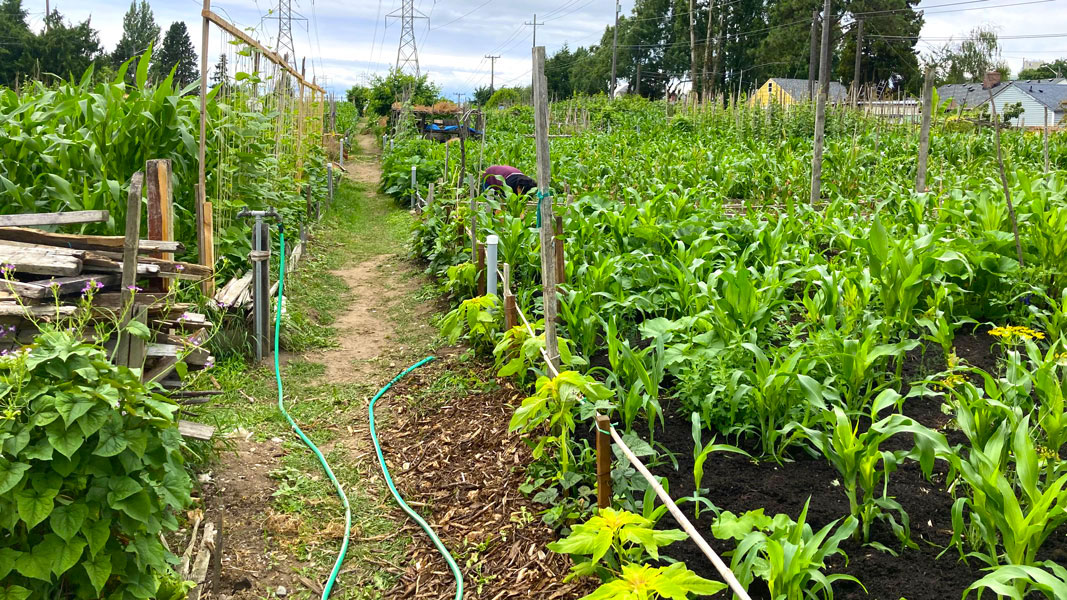Top: High yield urban agriculture plot amended with recycled organics such as compost and biosolids-based garden soil. Photos by Sally Brown
 Sally Brown
Sally Brown
Planting season is almost upon us. I just ordered my onion starts and leeks today. The tomato seeds, saved from last year, are about to be set in soil indoors. But a new paper published in Nature Cities says that if I really care about carbon emissions, I should forgo the planting and head instead to Amazon Fresh (Hawes et al., 2024). In fact, the paper claims that urban agriculture has six times the carbon intensity of conventional agriculture. My first question was whether the authors had ever been to the Central Valley in California. My second question was what kind of urban gardens they were talking about — clearly not like the garden I grow in or most that I’ve seen.
For better or worse, the paper is well done. The authors used survey results from gardens across France, Germany, Poland, the United Kingdom and the U.S. The research was based on prior work where people from the gardens used Citizen Science (a tool to allow people to collect their own data that is then used for research). The research team got information from people that gardened communally, on individual plots in community gardens, and on urban farms where produce was grown to sell, based on a study published in 2023 in Agronomy for Sustainable Development (Dorr, et al., 2023). (Links to both papers are in the reference section below.) That paper had pictures of the gardens. They looked like regular urban gardens, not so much like futuristic hydroponic rooftop extravaganzas.
While the methods in the Hawes et al paper seem sound, the results made no sense to me. Hawes, et al. took the data collected by Dorr, et al., and put it through a model for life cycle assessment. None of the assumptions in the model that they used were shared. The model, Ecoinvent, is proprietary and costs a lot more than a few pounds of tomatoes (even heirlooms) to access. I will do the best I can to go over the information in the Hawes’ paper and put it into perspective.
Yield Equals Knowledge
Their carbon balance starts with yield. Emissions are calculated based on the carbon intensity per serving. They say that urban agriculture emits 0.42 kg carbon dioxide equivalent (CO2e) per serving of produce or 3.12 kg CO2e per kg of produce. In contrast, that endless field of cauliflower only emits 0.07 kg CO2e per serving or 0.032 kg CO2e per kg. They note high variability in yield in an earlier paper (0.2 to 6.6 kg m2) — aka going from enough for a bite to inviting the extended family over kind of variability in yield (Dorr et al., 2022). An average yield was 1 kg of food for each 0.53 m2 of land.
Yield is going to vary based on your soil, your knowledge of how to grow food and the quality of the amendments that you use. In a study we did (Una, T. et al., 2022), kale yield for plants grown in pots in the greenhouse ranged from 1.5 g (fertilizer poor soil) to 104 g (vermicompost + poor soil) (Una et al., 2022). The kale grown with decent soil and fertilizers weighed in at 62 g. The results from this study would likely have been more favorable to urban agriculture if yields had been more reflective of people with sufficient knowledge and sufficient access to appropriate amendments.
The authors of both papers note high variability in their results. To put their summary results into perspective, I’ve guessed at best-case and worst-case scenarios for the different components that make up their analysis. Here is my assessment for yield:
- A best case here is a gardener with knowledge of how and when things grow with access to high quality locally produced composts.
- A worst case is someone who is not quite sure if potatoes grow on top of the ground or under the ground who adds various miracle mixtures and too much water in the hopes that something will grow.

Best case is a gardener with knowledge of how and when things grow, and has access to compost. Worst case is a gardener who doesn’t know if potatoes grow above or below ground.
What Contributes To Emissions?
While the authors didn’t provide the emissions default factors associated with the different categories, they did provide a list of categories responsible for the estimated emissions. The list included the number of farms in each category where that category was the one that contributed most to the carbon deficit. Here are the top four: Compost home-made: 22 gardens; Garden structures: 13 gardens; Water use: 6 gardens; and Raised beds: 5 gardens.
In addition to “Compost home-made,” several others made it into the general “soil” category including industrial compost (1), potting soil (2), soil or substrate (2), and synthetic fertilizer (5). Let’s start here. While the authors say that even when they disregard “compost home-made” related emissions, urban agriculture still falls behind. We don’t know what their assumptions are or what their baseline data is. Depending on the assumptions used, this could be a very solid estimate or it could be Google maps gone wild, stranding you deep in the urban jungle. It is also critical to point out here that urban agriculture is as different and varied as the people who participate in it.
- A best case is gardeners who amend their soil with compost made from material that would have otherwise gone to the landfill (biosolids or food scraps). The compost is made in a commercial facility with strong odor controls that also destroy any fugitive emissions. The compost is delivered to the site in bulk and no additional fertilizer is used. The plant waste at the garden is composted in a well- maintained bin with browns routinely added. Here methane avoidance from landfill diversion is likely enough to more than level the playing field. Add to that soil carbon sequestration, fertilizer avoidance, increased yield from quality amendments and you might just come out ahead.
- A worst-case scenario is gardeners who amend their soil with fertilizer and “boutique” compost purchased in small bags from a big box store. The local feedstocks for composts (biosolids and food scraps) are sent to the landfill. Plant waste at the site is piled up without any attention paid to addition of browns or turning, resulting in fugitive methane emissions. Here those landfill methane emissions would likely dig a hole deep enough to bury any benefits. Driving to and from the store to get those 20-pound bags of compost only adds insult to injury.

Best case is example of gardeners in Tacoma (WA) who use Tagro, a biosolids-based amendment. Worst case is a garden using no Tagro or similar recycled organics, with the biosolids sent to the landfill.
A quick caveat: I am not at all clear where the authors drew the line of what they considered and what they left out. As they focused on data collected from Citizen Science, they likely didn’t look far outside of the garden. That would suggest that the food scrap/ biosolids management of the community where the gardens were located didn’t figure into their estimate. That would have a huge impact on their results.
Garden Infrastructure
Let’s turn to the next major category. Both raised beds and garden structures (the authors use the term garden “houses”) fall under the general theme of garden infrastructure. Infrastructure requires materials to build. Whereas in conventional agriculture, a barn and or a location for refrigeration/ washing/storage is built to accommodate many acres with the intention of it lasting for many decades, urban farms often have short life spans. In addition to not lasting long, one garden structure for 20 or 30 gardeners is a lot more carbon intensive than one barn for 20 or 30 acres. Here it is likely that many of the urban farmers who participated in the study used new materials for construction, further impacting the carbon footprint.
- Best case here are gardeners who make use of recycled materials for raised beds and walkways. No concrete, no trips to the big box lumber store for supplies.
- Worst case are gardeners who buy a lot and buy new. Concrete here is the enemy. It may be great as a way to eliminate weeds and dust but it has a very high carbon footprint. Fixed structures in urban agriculture have high emissions unless they are built from recycled materials.

Best case is gardeners who use recycled materials for garden infrastructure. Worst case is those who buy new and buy a lot.
Final Thoughts
A critical thing to understand is that all garden types did not come out equal in the paper’s analysis. Urban farms were close to conventional agriculture in terms of carbon emissions. Within three years after establishment, emissions from urban farms were lower than traditional agriculture. Urban individual gardens (plots in a community garden) were higher and urban collective gardens were by far the highest in terms of emissions. The break-even point for community garden plots was estimated at close to 80 years. For communally farmed gardens, that break-even point was not even a dot on the horizon. In other words, urban agriculture even using whatever default factors and estimates that the authors had access to, is not in and of itself inherently an enemy of green growing. The way that it is currently done may just be a long way from the optimal case.
I realized as I was fretting over this study that my knowledge of urban agriculture is biased by my own experiences in my garden and by surveys I’ve done of community gardens in Tacoma, Washington, managed by the Harvest Pierce County program. Gardeners there are provided with as much biosolids-based potting soil as they need. They also have had access to yard trimmings compost. The city also offers yard trimmings collection and composting at a commercial facility, minimizing any potential for fugitive emissions.
This is not only excellent for carbon accounting, it grows great carrots and broccoli and tomatoes and any other vegetable you might think of. Gardeners are provided with cardboard and wood chips — both diverted from the solid waste stream to make pathways. Material for raised beds is also provided — here they used wood from stop signs that were knocked over Recycled pallets work too. There is also an active gleaning program, making sure that wasted food is minimized. Harvest Pierce County offers a range of education and outreach programs, including seed sharing and plant giveaways. With this as my point of reference, it is no wonder that the conclusions in the article made no sense.
The authors point out that even with high carbon emissions urban agriculture has a wide range of benefits. As I’ve written previously those can include better eating habits, more physical activity, a connection to nature and to neighbors, reduced crime, and better mental health. Often these programs exist without a full integration into the municipal structure where they are located. The mutually beneficial ties that the Tacoma program has taken advantage of go unrealized. Without knowing the assumptions that the authors used, I would wager (and more than a nickel) that the Tacoma example performs better than conventional agriculture. I wish that in this paper, in addition to presenting median values, the authors had also given a best- and worst-case example for each category, similar to my analysis in this column. That would have provided tools to strengthen urban agriculture rather than providing an excuse to let it wither.
Sally Brown, BioCycle Senior Adviser, is a Research Professor at the University of Washington in the College of the Environment.













